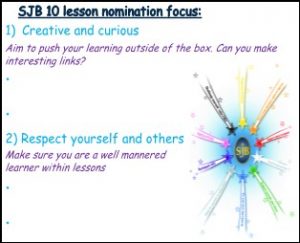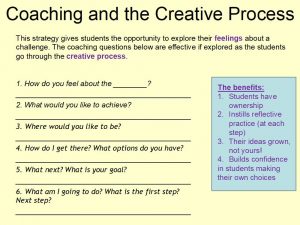Why did you decide to undertake this project? What was it designed to achieve?
With a continued whole-school focus on praise and a personal interest that I had in this matter, engagement was an area that seemed necessary to focus on in relation to student well-being and outcomes. GCSE results showed that girls out perform boys by around 12% (5 GCSE’s of grades 9-5 including English and Maths).
Research summary
Initial research came from the work by Pinkett and Roberts (2019) and their book ‘Boys Don’t Try’. Though this work was done with the caveat of being more focused on masculinity in schools, areas of it were well suited to the main focus of my research project. The chapter entitled ‘The engagement myth’ set out the argument that teachers assume that boys prefer competition and learning linked to their interests is in fact detrimental and superficial. They state that we should ‘teach boys in exactly the same way as girls.’
Developing upon the research from Pinkett and Roberts I furthered my research and looked into the findings of Hattie, Didau, Gorrard, See and Davies and the following findings were found out.
- Safe environment to learn- self confidence and success leads to motivation
It is through fostering positive student-teacher relationships that students make above average achievement and therefore motivate themselves to succeed (Hattie 2009). Along with setting high expectations in the classroom, as teachers, we need to have a classroom environment where students are willing to take risks with their learning whilst being resilient when it comes to making mistakes. The work of John Spencer highlights the fact that giving students ownership can lead to greater empowerment, they become 21st century self-directed learners.
- Collective responsibility- positive relationships increase motivation as students feel valued, competent and in control
Having a classroom where there is a ‘buy in’ culture of all involved is crucial with beating the engagement myth. Creating an environment that is safe and positive is the fundamental aim for us as teachers. Though it may seem to be a simple point as Didau and Rose (2016) remark ‘students are likely to be better motivated to work hard if we satisfy their need to be valued, competent and in control.’ Equally this has been evidenced within the Journal of school health (2004) and their list of three critical requirements that leads to students succeeding: high academic expectations, positive adult-student relationships and physical and emotional safety.
- High expectations- academic ability is prized above all other abilities by all students
Though this may seem simple there is often the danger that as teachers we already have pre-conceived expectation of students. We are often happy to rest when a student gets to where we want them to get. However, as Pinkett and Roberts (2019) write ‘academic ability is prized above all other abilities’ therefore as teachers we have a duty to stretch and challenge students to ensure that they are able to go further and deepen their learning. Gorrard, See & Davies (2012) also highlighted the importance of high expectations when they wrote ‘the way to succeed is not to assume poor motivation and confidence leads to low attainment but rather to increase motivation we need to let students succeed to develop confidence.’
Review of practice within school
Most of the findings within school came through collaboration with colleagues within the school’s Learning Group. Through discussion, I was able to compile best practices that were already taking place within certain departments and could be implemented within other areas of the school. Existing strategies used to challenge the engagement myth were:
- Clear and explicit praise – always explain why, praise to parents
- Enabling students to know where there learning journey was to go by looking at the big picture all the time
- The importance of the language that we use by fostering terms such as “us” and “we” rather than “me” and “you”
- Making intervention appropriate by putting the ownership on the student
- Forming positive relationships by letting the students know you’re human
- Giving students the chance to make mistakes and not feel embarrassed by enabling them to annotate iPad versions so they can make mistakes
- The use of paired discussion to overhear any good responses, telling them it’s correct and asking them to share
- Praising specific behaviour to build confidence
Based on the review it was clear to see that whilst there were many ways in which colleagues praised students when necessary, there needed to be a clear focus in ways in which praise could be done to effectively challenge disengagement and lead to greater student motivation within the classroom.
Thus questions that were identified were the following:
- If self confidence and success leads to motivation, how can we ensure all students feel they are doing well?
- If we want to increase motivation with some individuals, how can we ensure they feel valued, competent and in control in lessons?
- If ‘academic ability is prized above all other abilities by all students, are our expectations high enough of all students?
What impact has your project had on learning and teaching or outcomes in the school?
Considering the research and review of practices in our school, the areas we focused on as a school to challenge the engagement myth of students not wanting to learn were:
- High Expectations- academic ability is prized above all other abilities by all students.
- Safe Environment to Learn- self-confidence and success leads to motivation.
- Collective Responsibility- positive relationships increase motivation as students feel valued, competent and in control.
In the following section are a range of suggestions for lesson activities and systems that would enable teachers to harness praise and to increase student motivation. Many of them are not major changes to current practice but are instead designed to be reminders and suggestions for how to make more of praise within lessons.
Safe environment to learn- self confidence and success leads to motivation
As stated by Hattie (2009), having a classroom where students feel confident can impact the motivation that pupils have within lessons. Below are a number of simple but effective ways in which this safe environment can be fostered.
- Fortnightly foci for nominations within the department
A simple method is to have fortnightly nomination foci within a department. Using the schools reward system, the SJB 10, departments can focus on 2 areas to nominate students. From the outset, this results in students having something to aspire to and can be a way to challenge those who may ‘lack engagement.’ Additionally this not only brings about uniformity in the praise being given within departments but also highlights this as an important area to focus on within meetings, and makes the attainment of students key to learning and teaching.
 The image shown is from the RE department where they have trialled this within their lessons from the Christmas term on wards and has been an area of discussion within department meetings.
The image shown is from the RE department where they have trialled this within their lessons from the Christmas term on wards and has been an area of discussion within department meetings.
The below are comments from members of staff on the effectiveness of fortnightly foci for nominations:
- “Without having to focus on all of them (SJB 10) at once it meant time could be given to explaining the meaning at the top of the lesson and it also meant that my focus was sharpened because I was just looking for one attribute in students and students become more motivated.”
- “The nominations worked well with my yr 8 class. As it was mentioned at the beginning, and during the lesson, I think it seems more valuable, rather than making a quick decision at the end.”
- “In yr 9, those who were nominated at the end were certainly pleased to be nominated…. however I think the topic /activities had more of an impact on their engagement.”
- Student led nomination foci
Another simple way that uses nominations as a way to engage students is to ask students to choose the areas to be nominated on. A number of teachers have trialled this where after going through the lesson aims have challenged students to think what should warrant a nomination. One teacher stated; “giving students the ownership over the focus on the nomination criteria to be awarded at the beginning of the lesson gave students a feeling of empowerment and also increased their engagement overall in the lesson.”
- All engage with questions on iPad to then praise those least confident
Often within lessons the method of ‘hands-up’ results in the same students answering the questions. Instead one way to ensure all students attempt to answer, is to get all students to answer and then to show these responses to the whole class. This can cumulatively have an effective impact especially if praise is given meaningfully to th ose students who at times are reluctant to get involved either due to them coasting or for fear of making a mistake. Such an environment leads to all students feeling safe to get involved.
ose students who at times are reluctant to get involved either due to them coasting or for fear of making a mistake. Such an environment leads to all students feeling safe to get involved.
The image shown is from a DT lesson where this practice has been embedded within lessons.
Collective responsibility- positive relationships increase motivation as students feel valued, competent and in control
Fostering a classroom where there is a collective responsibility among teachers, students and LSAs can lead to increased motivation.
- Small Key Stage intervention with those disengaged students who need a boost
One way that we can foster collective responsibility is through small key stage intervention. A number of colleagues have trialled this in a variety of ways. For example, within Media and RE, dedicated  parts of a lesson have been set aside where intervention can be made to aid or assist those students who may be struggling or are lacking confidence and therefore may feel de-motivated. Intervention embedded whilst the majority of the class are working on a task allows for subtle support that enables them to achieve.
parts of a lesson have been set aside where intervention can be made to aid or assist those students who may be struggling or are lacking confidence and therefore may feel de-motivated. Intervention embedded whilst the majority of the class are working on a task allows for subtle support that enables them to achieve.
The image is shown from a media lesson where there was time given spent reflecting, being honest and talking about how they could develop their creative ideas, something that can be often rushed or overlooked as part of the teaching and learning process.
As the research shows students prize academic ability above anything else therefore targeted intervention within lessons can aid students’ progress towards this and in turn make them feel valued with minimal effort.
- Use LSAs to also highlight a positive change in learning with individual students
Considering effective ways to utilise LSA’s can help increase the positive relationships within the classroom. Developing on the idea that students make best progress where there are positive adult-student relationships, a number of teachers in departments such as RE, Maths and Science have trialled using an LSA in lessons to highlight where they have seen an improved engagement from individuals. Although not ground-breaking this can have real positive effects particularly on those who are not always praised. The comment below from an LSA highlights the positive impact that it can have.
- “Being able to nominate students who have made really positive decisions within lessons that normally may be picked up on for the wrong reasons has been so beneficial for the motivation and engagement of those students who may not have always been fully engaged.”
High expectations- academic ability is prized above all other abilities by all students
As research shows setting high expectations within the classroom can lead to students succeeding and developing in confidence.
It also can improve self- esteem if students feel they are academically able.
- Add, Build, Challenge
One effective way that can ensure that all students are set high expectations is through Add, Build, Challenge (A, B, C) tasks. Often students, especially those who lack motivation, will only demonstrate low level thinking skills when set written tasks. A, B, C ensures that all students build on their initial responses and further challenge themselves through the structure of the 
 activity. This often results in students feeling more confident and thus resulting in that prized academic ability being fostered.
activity. This often results in students feeling more confident and thus resulting in that prized academic ability being fostered.
This has been trialled within a number of departments where an improvement of written work has been evident. The following image is from a slide within a RE lesson where A, B, C tasks have now been embedded within their mastery model for learning.
- Ensure all are encouraged to Master a task or to move onto challenge tasks

A number of teachers, for example within the RE department, have ensured that within lessons all students move onto challenge tasks as an expectation. An added emphasis upon this within lesson planning has led to greater motivation from students and therefore deepened learning being made by students more regularly. The image attached is part of the KS3 planning where challenge tasks been embedded within each lesson on the scheme of work.
What do you think are the next steps in order to develop this aspect of learning and teaching in the school?
In order to ensure that we challenge the engagement myth with students not wanting to learn across the school, teachers should work to embed a few strategies that have come from this project. Though it is not always easy to measure the progress made in a quantitative manner it is clear from the research that simple adjustments within our teaching, such as allocated time to intervene with students who may feel disengaged, can over time result in a culture of high challenge, motivation and most importantly students aiming for that prized academic ability that is clearly desired by all, as stated by Pinkett and Roberts. Small embedded changes within departments can have a big impact on student outcomes. Therefore, to try and grow this project there are a number of next steps that I suggest:
- Big departmental push on nomination of students- get this as an embedded practice
- Try and implement 1 or 2 of these strategies within each lesson
- Ensure that LSAs are deployed effectively within lessons
- Focus on ways in which departments can foster greater the student/peer, or student/student intervention within lessons in relation to the Mastery model
- Within collaboration for Mastery have a focus on engagement of students where this is the main focal point
Some to take away: top tips for teachers
- Aim to ensure that students feel safe when they are learning through targeted praise that may lead to an increase in self confidence as well as rewards that lead to motivation
- Use lesson time effectively to ensure students feel valued and competent, this can be done through effective use of LSAs to praise or subtle intervention to close gaps in understanding.
- Ensure consistent high expectations of all students resulting in prized academic ability achieved by all.
Bibliography:
- Didau, and Rose, Nick (2016) What Every Teacher Needs to Know About Psychology (Woodbridge: John Catt Education Ltd)
- Roberts, and Pinkett, Matt (2019) Boys don’t try? Rethinking masculinity in schools (Routledge)
- Gorard, S., See, B. H., & Davies, P. (2012). The impact of attitudes and aspirations on educational attainment and participation. York: Joseph Rowntree Foundation.
- Didau, D., & Rose, N. (2016).What Every Teacher Needs to Know about… Psychology. John Catt Educational Limited.
- Didau, D (2015) 20 psychological principles for teachers #9 Motivation. https://learningspy.co.uk/psychology/20-psychological-principles-for-teachers-9-motivation/
- Hattie (2009). So…can you do anything about motivation? https://www.teachit.so/motivation.htm
- Klem, A. M., & Connell, J. P. (2004). Relationships matter: Linking teacher support to student engagement and achievement.Journal of school health, 74, 262-273
- King Edwards Grammar School (2017)KEGS Education Literature Bulletin – Issue 9 – David Didau and Nick Rose on “What every teacher needs to know about Psychology” – Part Two (of three): motivation and behaviour. https://www.kegs.org.uk/filedownload/8B61B079-D7F4-F218-D9FA2067166A4323.pdf/kegs-education-literature-bulletin-9-didau–rose-part-2.pdf